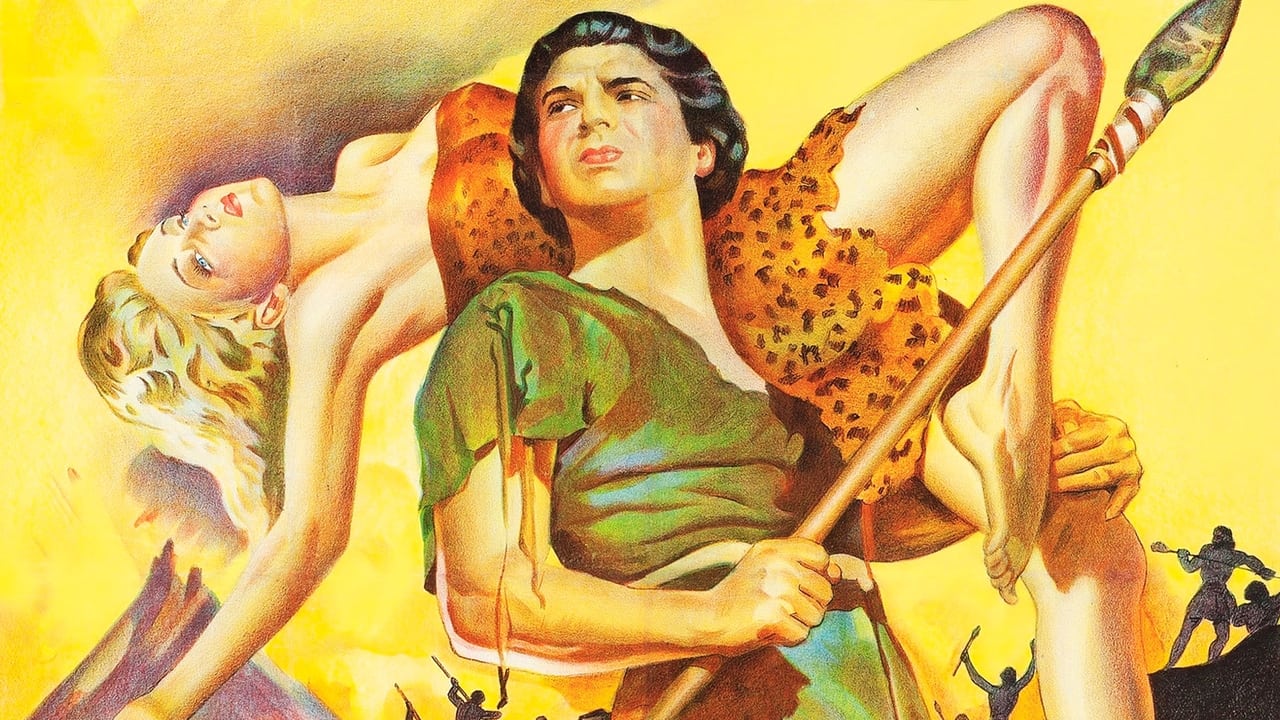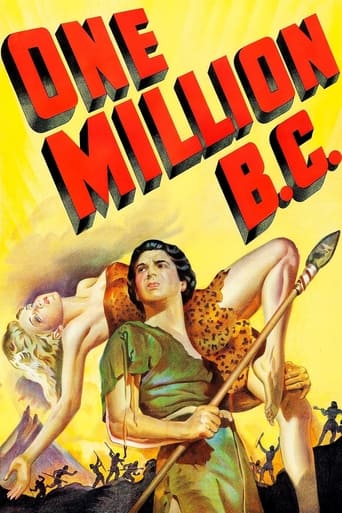

One Million B.C. did good business on its release in 1940 and, despite the years, parts of the film have aged remarkably well. One of these is not its entirely unnecessary opening sequence, in which a bunch of hikers dressed in German lederhosen take refuge in a cave and happen upon a wizened pipe-smoking palaeontologist who, as the resident "expert", spins a yarn to his captive audience about cave people that, with the help of a dissolve, is dramatised for us on screen. This early sequence is so slow and contrived that contemporary audiences may not have the patience to get past it, which is a shame as parts of the film thereafter are quite absorbing and contain a decent dose of the spectacle that made fantastical prehistoric films so appealing. Directors Hal Roach Sr. and Jr. seem to at times approach their prehistoric tale from an anthropological perspective which both helps and hinders the film. They seem so concerned with representing the lifestyles of the prehistoric folk with such authenticity (!) that the action is at times painfully slow and at others simply laughable: prehistoric humans and dinosaurs did not exist simultaneously (a forgivable error in dinosaur films as facts have never stood in the way of Hollywood spectacle), but more glaring is the final scene which imposes a bizarre message about the sacredness of the contemporary nuclear family structure. Equally baffling is the idea that although speech has not yet developed beyond grunts and two syllable sentences, the more complex language of music is a given. The two tribes represented on screen are clearly at different levels of social advancement with Victor Mature, as Tumak making an unsuccessful grab for power in his own tribe that ends with his shunning and adoption into a more civilised order, with mixed results, Efforts to show the tribes levels of socialisation are at times so laboured that they become redundant and drag out for far too long. But dull moments aside, there are some remarkable sequences that will actually impress contemporary audiences if they can endure the slower moments. One such moment is the volcanic eruption and earthquake that causes rockslides and a lava flow that engulfs one of the characters in a scene that may have you wondering how on earth this was achieved without killing the actor. For lovers of practical effects, if you can get past the slow moments that dog this film and drag it out unnecessarily, you will find some impressive moments that still stand up no doubt inspired later dinosaur films such as the highly successful 1966 Hammer studios film One Million Years B.C. that follows the narrative as this Hal Roach creation.
... View MoreUsually it's not a good sign when your favorite part of a movie is the opening five minutes, because that means the movie goes downhill from there. This might be the exception to that because, despite the opening being my favorite part, the rest of the movie is entertaining as well. This movie begins with some travelers seeking shelter from a storm inside a cave. But in the cave is an archaeologist (Conrad Nagel), who is studying paintings on the cave walls left by primitive man. The travelers are interested in the paintings so Nagel tells a story based on his interpretations of them.The story is about caveman Tumak (Victor Mature) of the rock tribe, who is hurt and taken in by the shell tribe. The shell tribe are gentle, peaceful people, unlike the rock tribe which is violent. Tumak gradually becomes one of the shell tribe and falls in love with their ways and the beautiful Loana (Carole Landis). As the story progresses, the cavemen must contend with various monstrous creatures. An almost unrecognizable Lon Chaney, Jr. also appears as a bearded member of the rock tribe.Mature makes for a funny caveman but Chaney seems right at home. Landis plays the sweet innocent Loana well and looks very attractive in the skimpy cavegirl outfit. The special effects are cheap by today's standards but don't seem out of place here. They range from a guy in a dinosaur suit to animals optically enlarged by photographic trickery to a big volcanic eruption. Quaint as these effects may seem today, the film was nominated for a special effects Oscar. Stock footage from this movie would be reused over and over in the next few decades. The musical score is pretty good and was also nominated for an Oscar.It's an enjoyable movie but one that requires patience. The lack of dialogue makes the pace drag some and that's tough for what is essentially a simple adventure story. Still, it's good fun if you see it when you're in the mood for such a movie.
... View MoreAlthough I am not that much of a fan of the 1966 Hammer color remake to begin with – or caveman epics in general – I had always been intrigued by the original 1940 black-and-white version which, apart from being arguably Hal Roach's most ambitious undertaking, was (ostensibly) a pioneering work in special effects and, furthermore, served to give Victor Mature his first starring role. Although a friend of mine (who is the No. 1 fan of the latter that I know of) does have a 16mm print of this under its British title MAN AND HIS MATE, I eventually managed to track it down via a TCM USA screening. Having now watched it for myself, I cannot say that it has served to endear the genre in my eyes or make the thin plot any more compelling than in the Hammer version. Firstly, the special effects may have been nominated for an Oscar, have a primitive {sic} charm about them and been re-utilized in many another cheap production thereafter (notably the abysmal ROBOT MONSTER [1953]) but the various anachronistic dinosaurs look far too much like magnified-lizards-shot-on-miniature-sets to be believably dangerous; a long-drawn out battle between two such 'monsters' is a particular liability! Besides, the grunt-laden 'dialogue' grows alternately silly and tiresome as the film progresses; at least, the film-makers have provided a prologue in which modern day travelers take shelter from the rain in a cave and a residing(?) anthropologist entertains them by interpreting the age-old illustrations on the walls as re-enacted by themselves. At the age of just 33, Lon Chaney Jr. is made up to look much older and play Mature's dad while the latter – sporting a full head of hair a decade before SAMSON AND DELILAH (1949) – appears decidedly schoolboyish; still, what is even harder to accept is how blonde Carole Landis blossomed amidst these surroundings! This is not to say that the film is unentertaining or badly made because it really is not; in fact, the climactic volcano eruption is very well staged and the film's undeniable highlight, the set decoration appropriately atmospheric and Werner R. Heymann's rousing score was deservedly singled out by the Academy for Oscar consideration. Incidentally, for years it was believed that forgotten cinema pioneer D. W. Griffith – whose famous two-reeler MAN'S GENESIS (1912) may well have inspired the film to begin with – had been actively involved in the production before getting the sack from Roach, but his contribution has since been disputed as having been all too minimal (unless our resident Griffith expert wants to give his informed account of the matter).
... View MoreImagine a world one million years ago. With people who inhabit a dark and dangerous unfriendly world, where they tend to dwell in the shadows of prehistoric reptiles and other ancient monsters. Where men live in caves and use the most primitive of weapons for competition, defense, and hunting the great beasts of their age. And you have a picture of what you will see in this 1940 adventure film, "One Million B.C." This film, while it may be ahistorical on many accounts, is a rather unique, entertaining little gem reminiscent from the dawn of the 1940s. If this were a documentary, the professors would be offended. Yes, cave men and dinosaurs did not inhabit the same world. And there are no records of iguanas and sail-backed crocodilians in excess of a hundred feet in length. But in my opinion, that is what makes movies like "One Million B.C." special. They are examples of what filmmakers thought about in the past. And the kind of movies that the naive audience found spectacular decades ago."One Million B.C." is pretty much your kind of ancient love story and it may even be trying to symbolize that the people from the ancient world were not all barbarians and like animals and that they had their own way of life with emotions and problems very much like ours today. This is explained after the first five minutes or so, because the film is basically a flashback. Starting in the present day and then remembering what happened long ago. And while it may not be an incredibly powerful romantic film, it is a great look at old film-making.The special effects used on the monsters that no longer exist are acceptable for the time the film was made. Obviously, the constraints of the budget did not allow for the expensive stop-motion animation technique from the 1933 "King Kong" or the even earlier 1925 "The Lost World". Dinosaurs here are portrayed in three different ways: men in rubber suits, puppets and props, and most commonly used graphically enlarged lizards and other reptiles. Its a look into the time when visual effects were still under development. And maybe it was the filmmaker's way of trying to convince the audience that what they were seeing was real. And by adding sound effects as the reptiles opened their mouths, could have frightened the audience back then. Some special effects weren't as keen, though, most primarily the tyrannosaurus and the triceratops. The triceratops was a small prop that was nearly immobile. And the tyrannosaurus was a man in a suit that provided very choppy, revealing motions. Nonetheless, the sequences with these two creatures was quite fun. Campy, but fun. And as for the graphically enlarged lizards, they worked out fine on the most part. But they had to be formatted with the actors to make them appear gigantic. There are many cases in the film where you can see the creatures were altered to make them look ancient. For example, there is a crocodilian in the film with a sail upon its back. Obviously, a small caiman or alligator with a rubber fin placed onto its armored hide. It just shows how the special effects artists at the time were being forced into using their ingenuity and imagination."One Million B.C." is a nice little gem and in my opinion, it's an underrated film. Maybe it started out of a bit of a weak level and kind of rushed through to the main part of the story, but the rest of the film was entertainment at a naturally fine level. Also featuring a very well, Academy Award-nominated musical score that was dark and ominous, perfect for enhancing the appearance of a world gone. In actuality, a world that never really existed according to science. It's an imaginary world, but one that you can look at and believe.
... View More